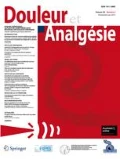Résumé
Nous avons étudié, en double aveugle, l’effet antinociceptif de l’acide acétylsalicylique dosé à 0,6 g et d’un placebo (lactose) sur une douleur expérimentale dentaire chez 17 sujets normaux. Le placebo, comme l’acide acétylsalicylique, produit une réponse analgésique statistiquement significative par comparaison avec les réponses de contrôle obtenues au cours des séances sans traitement. La comparaison des réponses analgésiques au placebo et à l’acide acétylsalicylique ne montre pas de différence significative pour l’ensemble de la population. Par contre, après avoir séparé les sujets en «placebo-répondeurs» et «placebo-non-répondeurs», nous avons pu mettre en évidence un effet analgésique de l’acide acétylsalicylique statistiquement supérieur à celui du placebo dans le groupe «placebo-non-répondeur». Aucune différence significative entre l’effet du placebo et celui de l’acide acétylsalicylique ne peut être montrée dans le groupe «placebo-répondeur». Ainsi, la séparation des sujets en placebo-répondeurs et placebo-non-répondeurs permet de démasquer l’effet antinociceptif de substances à faible pouvoir pharmacologique.
Summary
Placebo and acetylsalicylic acid (0.6 gm) analgesic effects were studied in double blind in a within-subject-repeated-measures experiment using an experimental dental pain test in 17 normal subjects. Compared to the no-treatment condition, both treatments produced significant analgesic effects. The placebo analgesic effect was very powerful and no statistical difference was found between placebo and aspirin data for the whole population. However, after separating the 17 subjects into placebo-responders (PR) and placebo-non-responders (PNR), significant difference between placebo and aspirin effects was elicited in the PNR group, whereas no statistical difference was found in the PR group. This result is in accordance with previous studies, which have shown that, when the PR subjects are screened out, more precise information can be obtained in pharmacological studies.
Bibliographie
American Psychiatric Association, Diagnostic and Statistical Manual of Mental Disorders (3d ed). Washington DC, American Psychiatric Association, 1980.
Batterman R. C.: Placebo and nonreactors to analgesics.Fed. Proc. 16, 280, 1957.
Beecher H. K.: The powerful placebo.JAMA 159, 1602–1606, 1955.
Beecher H. K.:Measurement of subjective responses: quantitative effects of drugs. Oxford University Press, New York, 1959.
Beecher H. K., Keats A. S., Mosteller F. andLasagna L.: The effectiveness of oral analgesics (morphine, codeine, acetyl-salicylic acid) and the problem of placebo «reactors» and «non-reactors».J. Pharmacol. Exp. Therap. 109, 393–400, 1953.
Darwin C.:L’expression des émotions. Reinwald, Paris, 1874.
Dworkin B. R., Lee M. H. M., Zaretsky H. H. andBerkeley H. A.: Instrumentation techniques. A precision tooth-pulp stimulation technique for the assessment of pain threshold.Behav. Res. Meth. Instrum. 9, 463–465, 1977.
Ernst M., Lee M. H., Dworkin B. andZaretsky H.: Pain adaptation to repetitive dental electrical stimulation; influence of naloxone.Pain 26, 221–231, 1986.
Evans F. J.: The placebo response in pain reduction.Adv. Neurol. 4, 289–296, 1974.
Gregoric M.: Habituation of the blink reflex (role of selective attention). In J. E. Desmedt (ed.),New Developments in Electromyography and Clinical Neurophysiology 3, 673–677, 1973.
Gryll S. L. andKatahn M.: Situational factors contributing to the placebo effect.Psychopharmacology 57, 253–261, 1978.
Harris S. C. andBlockus L. E.: The reliability and validity of tooth-pulp algesimetry.J. Pharmacol. Exp. Therap. 104, 135–148, 1952.
Houde R. W., Wallenstein S. L. andRogers A.: A clinical pharmacology of analgesics. A method of assaying analgesic effect.Clin. Pharmacol. Therap. 1, 163–174, 1966.
Jellinek E. M.: Clinical tests on comparative effectiveness of analgesics drugs.Biometrics Bulletin 2, 87, 1946.
Joyce C. R. B.: Consistent differences in individual reactions to drugs and dummies.Brit. J. Pharmacol. 14, 512–521, 1959.
Kuhn R. A. andBromiley R. B.: Human pain thresholds determined by radiant heat techniques and the effect upon them of acetyl-salicylic acid, morphine sulfate, and sodium phenobarbital.J. Pharmacol. Exp. Therap. 101, 47–55, 1951.
Lasagna L., Laties V. G. andDohan J. L.: Further studies on the pharmacology of placebo administration.J. Clin. Invest. 37, 533–537, 1958.
Lasagna L., Mosteller F., Von Felsinger J. M. andBeecher M. K.: A study of the placebo response.Am. J. Med. 16, 770–779, 1954.
Levine J. D., Gordon N. C. andFields H. L.: The mechanism of placebo analgesia.Lancet 2, 654–657, 1978.
Levine J. D., Gordon N. C., Bornstein J. C. andFields H. L.: Role of pain in placebo analgesia.Proc. Nat. Acad. Sci. USA76, 3528–3531, 1979.
Liberman R.: An experimental study of the placebo response under three different situations of pain.J. Psychiatr. Res. 2, 233–246, 1964.
Sherman M., Fiasconaro J. E. andGrundfest M.: Laboratory evaluation of analgesics effectiveness in human subjects.Exp. Neurol. 7, 435–456, 1963.
Sonnenschein B. R. andIvy A. C.: Failure of oral antipyretic drugs to alter normal human pain thresholds.J. Pharmacol. Exp. Therap. 97, 308–313, 1969.
Sternbach R. A.:Pain: a Psychological Analysis. Academic Press, New York, 1968.
Thorn W. A. F.: Masters Thesis, Australian National University, 1962.
Wolf S.: Effects of suggestion and conditioning on the action of chemical agents in human subjects: the pharmacology of placebo.J. Clin. Invest. 29, 100–109, 1950.
Wolf S., Doering C. R., Clark M. L. andHagans J. A.: Chance distribution and the placebo-reactor.J. Lab. and Clin. Med. 49, 837–841, 1957.
Wolff B. B.:Behavioral Measurement of Human Pain, ed.: Sternbach, R. A., Raven Press (New York) p. 129–168, 1978.
Author information
Authors and Affiliations
About this article
Cite this article
Ernst, M. Influence du placebo-répondeur dans l’évaluation de l’effet antalgique de l’aspirine (acide acétylsalicylique). Doul. et Analg. 1, 27–33 (1988). https://doi.org/10.1007/BF03007378
Received:
Accepted:
Issue Date:
DOI: https://doi.org/10.1007/BF03007378

